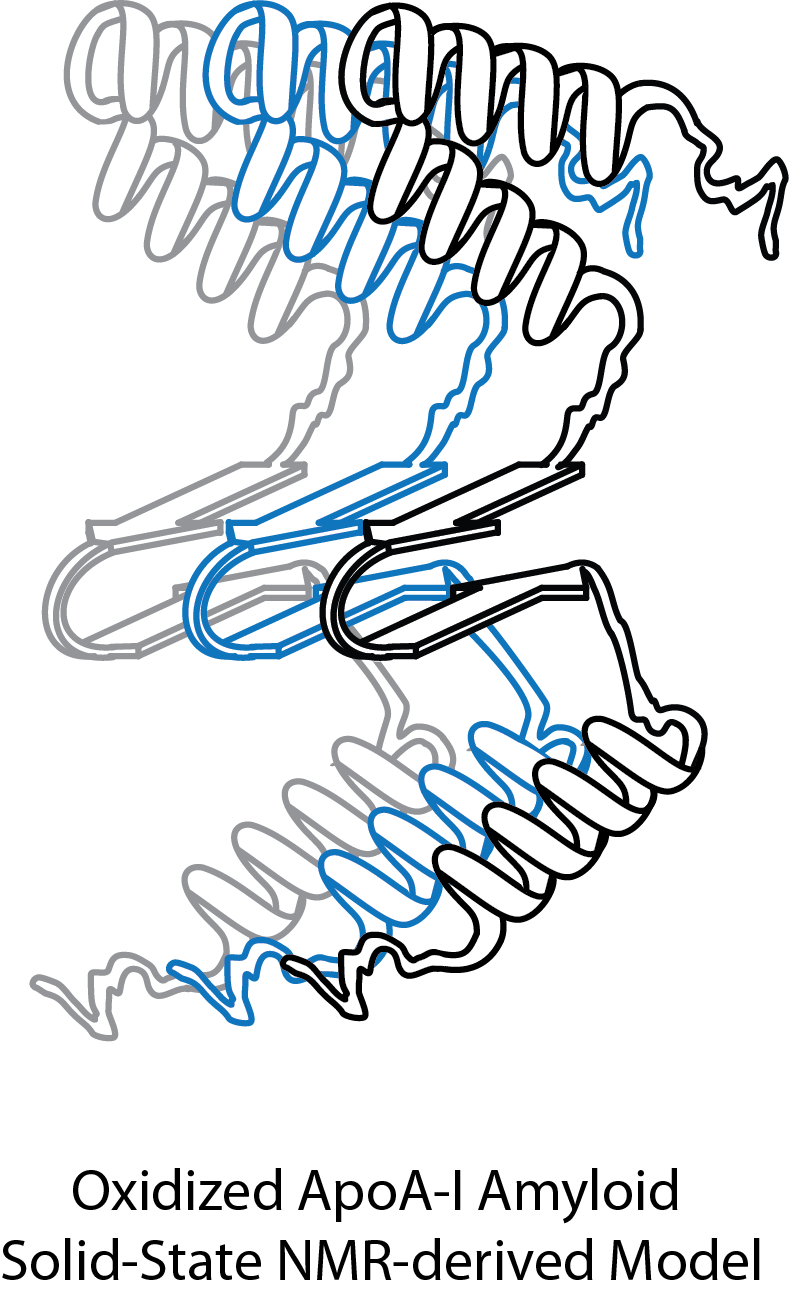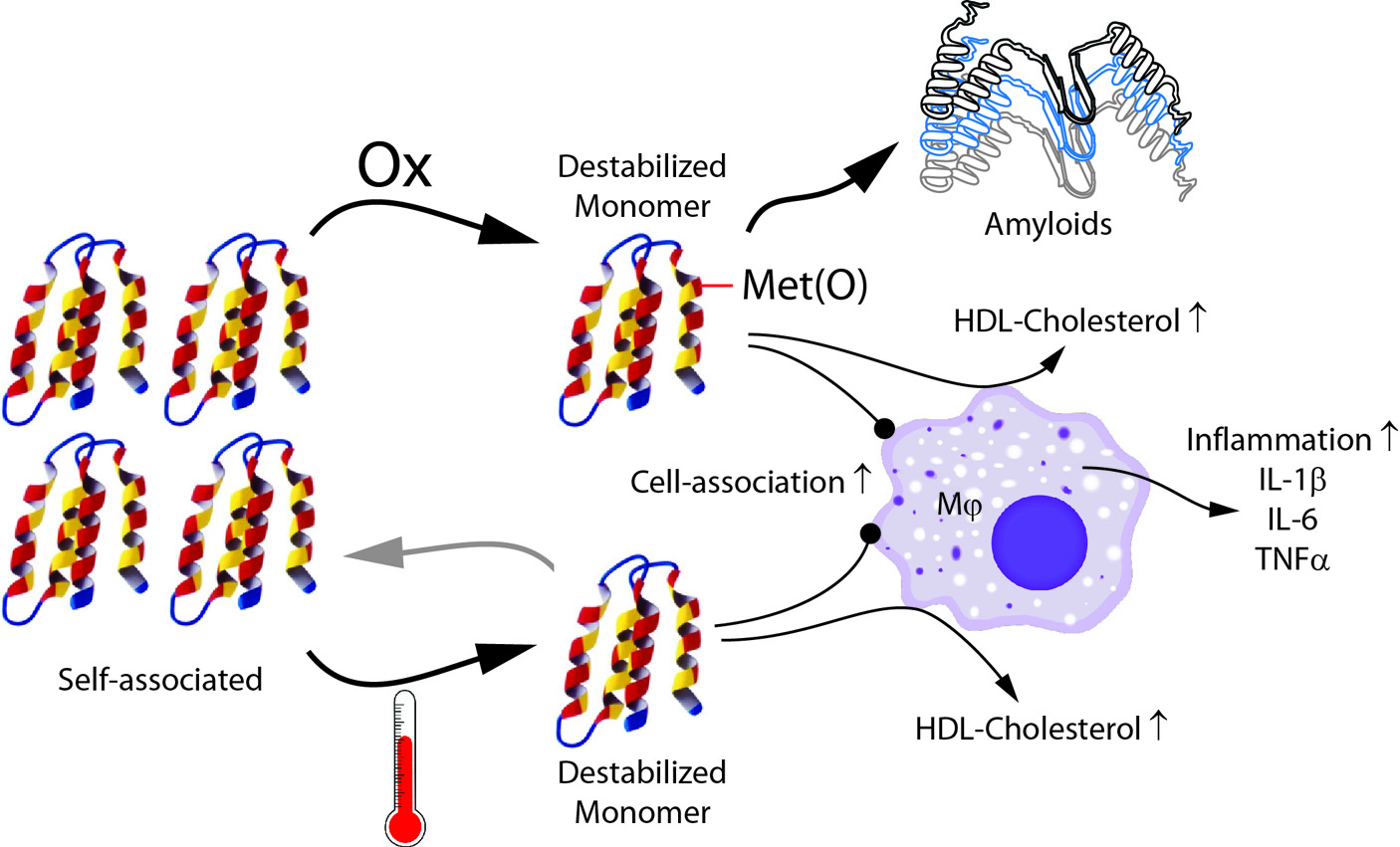The primary focus of Cavigiolio Lab research is lipoprotein metabolism and cardiovascular disease. Lipids (fats) are transported in blood in lipid‑protein assemblies known as lipoproteins. The protein components of lipoproteins are called apolipoproteins. In Cavigiolio Lab we seek to identify the factors that lead to dysfunctional apolipoproteins, and understand the mechanisms whereby dysfunctional apolipoproteins contribute to the development of atherosclerosis and cardiovascular disease.
Atherosclerosis is a complex disease of the arteries that starts with the deposition of oxidized lipids inside the artery wall in an area known as the subendothelial space. In response, the immune system recruits a type of white blood cell called macrophages to the subendothelial space to clear lipid deposits. When macrophages become overloaded with oxidized lipids, however, they die and transform into “foam cells” that contribute to the growth of the atherosclerotic plaque. Lipid levels, local inflammation, and oxidation levels in the atherosclerotic arteries are all factors that participate in the progression of atherosclerosis to a potential life‑threatening condition. Apolipoproteins are major players in controlling these factors.
In Cavigiolio Lab we investigate the structural/functional factors that determine the fate, whether beneficial or detrimental, of apolipoproteins in atherosclerosis. The long‑term goal of this research is to identify and eventually prevent apolipoprotein dysfunction, and thereby reduce the incidence of cardiovascular disease.
One of the functions of apolipoproteins is to promote cholesterol and phospholipid release from cells. Apolipoprotein A‑I (apoA‑I) is a foremost facilitator of this process as it extracts lipids from peripheral cells and generates high density lipoproteins (HDL), which transport excess cholesterol from the periphery to the liver for excretion. Lipid release from cholesterol‑laden macrophages mediated by apoA‑I is thought to be one of the mechanisms that reduce foam cell formation and atherosclerosis progression. High plasma levels of apoA‑I have been shown to correlate with lower incidence of cardiovascular disease. What would normally be a beneficial apolipoprotein, however, can be harmful when its levels in parts of the body are very high.
Amyloids are insoluble deposits that consist of different types of proteins. An increasing number of clinical studies indicate that amyloid deposits are a significant component of the atherosclerotic plaque and that apoA‑I is a major precursor of these amyloids. ApoA‑I is a very abundant protein in plasma (about 1 mg/ml in normal conditions), where it is mostly associated with HDL. Local levels of apoA-I and other HDL‑associated apolipoproteins in the subendothelial space of atherosclerotic arteries can be several folds higher. Mechanisms promoting protein misfolding, such as oxidation and glycosylation, can lead to apolipoprotein aggregation due to the high local concentration of these proteins in the proximity of the atherosclerotic plaque; thus stability of apoA‑I and other HDL‑associated apolipoproteins is an important factor in atherosclerosis.

Exchangeable apolipoproteins are dynamic molecules that can
transition between their lipid‑free and
lipid‑associated forms and transfer between different
lipoprotein particles.
Lipid binding of apolipoproteins is
mediated by their most characteristic structural motif: the
amphipathic α‑helix, whereby hydrophobic and
hydrophilic surfaces are segregated on opposite faces of the
α‑helix. Lipids bind to the hydrophobic regions and
shield them from the aqueous environment.
In the absence of lipids, apolipoproteins fold in tertiary and quaternary structures, which sequester the extensive hydrophobic surfaces of amphipathic α‑helices in hydrophobic pockets that exclude water. Apolipoprotein stability and solubility in the polar medium are thus maintained. Intermolecular apolar interactions between amphipathic α‑helices aid in shielding the hydrophobic surfaces from solvent. The tendency for lipid‑free exchangeable apolipoproteins to self‑associate is a result of these interactions. Apolipoprotein A‑I, A‑II, A‑IV, E, and Cs all form soluble self‑associated species in solution. The Cavigiolio lab is currently investigating how exchangeable apolipoproteins' self‑association impacts their function.
Large population studies have shown that low plasma
HDL‑cholesterol levels (HDL‑C) are associated with high risk of
developing cardiovascular disease (CVD). Nonetheless, there are
numerous cases of severe CVD in patients with high HDL‑C.
A recent
genetic study challenges the existing paradigm and proposes that a
better biomarker of CVD risk could be obtained by evaluating the
functional quality of HDL, rather than merely quantifying HDL
cholesterol content. Reliable routine analytical methods are
needed to quantify HDL functionality in clinical plasma samples in
order to produce such a biomarker. We are using the inherent
ability of apoA‑I to transition between the lipid‑bound and
lipid‑free states as a functional parameter to assess HDL quality.
We have previously designed a fluorescent variant of apoA‑I that exhibits distinct emission spectra, depending on whether it is lipid‑free or HDL‑associated. Using this fluorescent apoA‑I as a probe of apoA‑I lipidation state, we showed that the pools of HDL‑associated and lipid‑free apoA‑I participate in a spontaneous "exchange" reaction. The kinetics of the exchange reaction, which we named “apoA‑I exchangeability”, were significantly reduced by apoA‑I crosslinking or oxidation by myeloperoxidase, which are apolipoprotein modifying events similar to those occurring in atherosclerosis. The Cavigiolio lab is building on this previous research by exploring whether “exchangeability” of apoA‑I can be used clinically as a measure of HDL functionality and as a predictor of a patient's risk of developing CVD.

Apolipoprotein A‑II (apoA‑II) is an exchangeable apolipoprotein produced in the liver with higher affinity for lipids than apoA‑I. HDL particles in human plasma contain either apoA‑I (HDL‑AI) or both apoA‑I and A‑II (HDL‑AI‑AII). Different HDL subclasses contain a variable amount of apoA‑I molecules but, strikingly, the molar ratio of apoA‑I vs. apoA‑II is roughly constant; it is equal to 2:1 in all HDL‑AI‑AII particle sizes.
Despite thirty years of research on apoA‑II, both the structure of apoA‑II‑containing HDL and the metabolic role of this protein are poorly understood. For example, the mechanism and the timing of apoA‑II insertion into HDL are not fully explained. Furthermore, a correlation between apoA‑II levels and incidence of cardiovascular disease has not been completely established. The primary obstacle in understanding apoA‑II function has been the unavailability of bacterially expressed recombinant apoA‑II. To overcome this technical limitation, the Cavigiolio lab, in collaboration with the Sean Davidson Lab (University of Cincinnati, Ohio), has developed an intein‑based bacterial expression system that produces highly pure mature human apoA‑II at substantial yields. The Cavigiolio lab is now using this expression system to generate variants of apoA‑II and investigate the structure and function of apoA‑II.
Cholesterol is primarily mobilized from cells (e.g. cholesterol‑laden macrophages) to lipid‑free apoA‑I via the membrane ATP binding cassette transporter A‑1 (ABCA1). Synergizing expertize from several collaborating research groups, we have demonstrated that alterations of apoA‑I native state of self‑association impairs its biological function. In particular, an increase in the levels of apoA‑I self‑association impairs apoA‑I lipid‑binding and ABCA1‑mediated lipid release from cells to apoA‑I. Conversely, we reported that oxidation of apoA‑I methionines ablates self-association and that monomeric oxidized apoA‑I is a pro‑inflammatory and amyloidogenic factor that induces secretion of pro‑inflammatory cytokines in macrophages and can aggregate into amyloids.
The hypothesis: in atherosclerotic lesions, sterile inflammation promotes oxidation of apoA‑I methionines and generates oxidized‑ApoA‑I, whose amyloidogenic and pro‑inflammatory activity reinforces local arterial inflammation and exacerbates atherosclerosis.
Main aims:
To this goal we continue to apply a complementary array of biophysical, biomolecular and cellular/animal techniques available in our lab or through established collaborations
Experimental techniques:
Cavigiolio Lab:
Protein expression/purification, protein fluorescence, spin and isotopic labeling, fluorescence spectroscopy, mass‑spectrometry, circular dichroism spectroscopy, size exclusion chromatography, cellular inflammation markers, in‑vivo inflammation studies.
Shinji Yokoyama Lab, Chubu University, Japan: ABCA1‑mediated cholesterol efflux studies.
Anna Rubartrelli Lab, Ospedale Policlinico San Martino, Genova, Italy: Cellular Inflammation pathways.
Patrick Van der Wel Lab, University of Groningen, The Netherlands: Solid‑state NMR.
John Voss Lab, University of California at Davis: Spin‑label electron paramagnetic resonance (EPR) spectroscopy.
Martin Zanni Lab, University of Wisconsin-Madison: 2D‑IR spectroscopy.

Summary of current results. ApoA‑I native self‑association is disrupted by thermal treatment or Methionine oxidation. Destabilized monomeric apoA‑I associates with macrophages more strongly and extracts cholesterol more efficiently than native apoA‑I. Destabilized monomeric oxidized‑ApoA‑I is amyloidogenic and induces a strong Toll‑like receptor 4‑dependent pro‑inflammatory response.
Cholesterol‑laden macrophages primarily release cholesterol to lipid‑free or lipid‑poor apoA‑I via the ATP binding cassette A1 (ABCA1). This pathway is believed to be one of the mechanisms whereby apoA‑I reduces atherosclerosis progression. However, lipid‑free/lipid‑poor apoA‑I is barely detectable in plasma, where the majority of apoA‑I is HDL‑associated. The mechanism by which lipid‑free/lipid‑poor apoA‑I is formed in the sub‑endothelial space of arteries is poorly understood.
The hypothesis: reduced apoA‑I “exchangeability” in dysfunctional HDL leads to lower local availability of lipid‑free apoA‑I and lower cellular lipid release through the ABCA1 pathway.
Aim: use apoA‑I “exchangeability” clinically as a measure of HDL functionality and as a predictor of a patient's risk of developing cardiovascular disease.
Experimental approach:
In Cavigiolio Lab, we generate lipidation‑state sensitive apoA‑Is using advanced protein chemistry techniques such as expressed protein ligation and click chemistry in order to label apoA‑I with specific fluorophores in selected positions. Making use of the fluorescence resonance energy transfer (FRET) properties of the fluorophores, we can then determine whether the apoA‑I is lipid‑free or HDL‑associated. The fluorescent and structural characterizations of the protein variants are performed by fluorescence and circular dichroism spectroscopies, and mass‑spectrometry. The fluorescent apoA‑I variants are used to quantify apoA‑I “exchangeability” in HDL from plasma samples.
How does apoA‑II associates with HDL and how does apoA‑II contribute to the regulation of HDL interaction with enzymes, and cell membrane receptors and transporters?
The hypothesis: specific regions or single amino acids are essential for maintaining apoA‑II native structure in the lipid‑free and HDL‑associated forms and preserving normal apoA‑II functional levels.
Aim: establish the most important structure/function determinants of apoA‑II.
Experimental approach:
To identify the essential structural and functional domains of the protein, we are mutating single amino acids or deleting entire regions in apoA‑II sequence by combining mutagenesis techniques and our intein‑based expression and purification system. We also label apoA‑II at specific positions with fluorophores to investigate how the protein self‑associates and associates with HDL. The protein variant are characterized structurally by circular dichroism and fluorescence spectroscopies, and mass‑spectrometry. Interaction of apoA‑II with other proteins on HDL is investigated by fluorescence spectroscopy. The cellular cholesterol efflux activity of HLD reconstituted using apoA‑II variants is evaluated on macrophages.
(* corresponding authors, # both authors equally contributed)
The Smoking Apparatus Video
The in-house-built cigarette smoking apparatus developed by the Cavigiolio Lab.
The smoking-machine allows to "smoke" a real cigarette controlling burning speed and smoke flow.
The smoke is conveyed through Tygon® tubing towards a reaction vessel where a reaction solution can be exposed to the smoke in controlled atmosphere conditions.